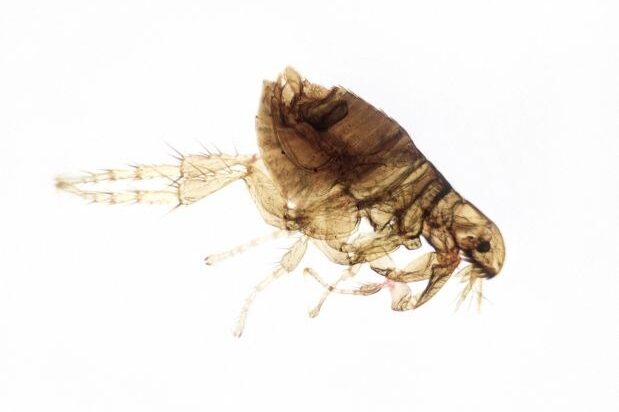Fleas
Fleas are tiny parasites that love to feed on your pet’s blood. The bites cause irritation and this can effect you and your family as well.
These bites often leave your pet scratching, which can lead to irritation and allergies. If fleas reside on your dog, it can lead to more serious health problems and you could get fleas in your home.

What Are Fleas?
Fleas are small, wingless insects that, although unable to fly, can jump great distances. In order to survive, fleas need a warm-blooded feed, and they’re not picky eaters – most pets can get bitten by fleas, and unfortunately, humans are also at risk.
How Do I Know If My Pet Has Fleas?
Itching, scratching, licking or biting – If you have more than one pet or any other furry pet in the house, you may find them itchy. You may even be itchy and see red bumps on the skin where the flea has bitten.
Flea dirt– Flea eggs are white and difficult to detect, but flea dirt (a mixture of flea droppings and dried blood) can often be seen on the skin of pets with fleas.It looks like small red-brown spots and can often be mistaken for dirt particles. You can check if the stains on your dog’s coat are real dirt or fleas by using a wet paper to check. Take a damp paper towel or cotton ball and gently wipe away some of the stain. If the area around the spot turns red-brown, it’s flea dirt.
Live fleas – You can see live fleas on your pet’s fur if you part or brush the pet’s fur back. However, fleas are very fast and can be difficult to detect! Around the base of the tail and around the neck are good places to look.
Hair loss and sores – If your pet is itching a lot, they may damage their skin, leading to sores and hair loss.
Tapeworms – If your pet has tapeworms, it could be due to fleas. Tapeworms can survive inside fleas and be passed on to your pet if they accidentally ingests fleas while licking his fur.
Cats:
Cats & kittens typically show the same signs of flea infestation as dogs, however there are some specific signs that cat owners should be aware of:
Miliary dermatitis -This is a very specific type of skin reaction commonly seen in cats allergic to flea saliva. Affected cats have small scabs on various parts of their bodies, but most often along their backs and around their necks, which look like small bumps under your fingers when you stroke them. You may see hair loss, especially along the spine and around the base of the tail.


When Should I Start Flea Treatment For My Pet?
Your vet will help- advise you on when to start flea treatment, but for most cats and dogs they can recieve their first treatment at aroound six to eight weeks old. The exact age will depend on the type of flea treatment chosen and the weight of your pet.
What Flea Treatment Should I Use For My Pet?
Flea protection comes in many forms, including pills, spot-ons, and collars. Weaker preparations and medications are available at pet stores, but the most effective prescription flea protection can only be provided through a veterinarian. Most flea preparations your veterinarian can provide will also help protect your pets against a variety of other parasites, giving you extra peace of mind.
BOOK AN APPOINTMENT

Can Fleas Affect My Health?
Fleas are not very picky and are happy to bite an animal and humans, which can cause itching and skin pain.
Flea bites can also cause more problems than just itchy skin. Bartonella (also called cat scratch disease) can be transmitted by flea droppings; either by accidental ingestion or through small cuts in the skin. Causing a mild fever and swollen lymph nodes, a bartonella infection can often be mistaken for the flu and in many cases clears up on its own. Unfortunately, in some people, a bartonella infection can develop and cause fatigue, chronic headaches, and can become very debilitating.
Flea Facts
A flea starts feeding on blood within 5 minutes and may suck blood for up to two and a half hours!
A single flea lays 40-50 eggs a day, thats up to 2,000 in a life time, from one single flea!
It can take a staggering 8 weeks or more to remove a flea infestation once it is established in a home!

Not Registered?
Don’t worry! We are always happy to welcome new clients and your lovely pets!
REGISTER TODAY